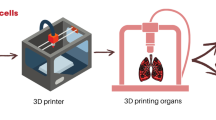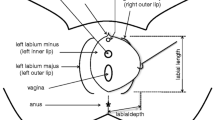Abstract
Purpose
Few researches have been conducted to develop an ideal method for tissue engineering of corpus cavernosum. We produce a decellularized human corpus cavernosum scaffold and investigate the in vivo cell seeding of the scaffold after transplantation into the rat omentum.
Methods
Eight adult human male corpus cavernosum were obtained in sterile condition. After dissecting the urethra, corpus cavernosum was decellularized by inserting an 18-gauge needle into the body of the tissue. The gauge was connected to a peristaltic pump to circulate the detergents in the corpus. Several assessments were performed to evaluate the efficacy of decellularization and extracellular matrix (ECM) preservation. A section of decellularized scaffold was washed several times and transplanted into the omentum of 4 male healthy Sprague–Dawley rats and located into the scrotum. Biopsies were taken 1, 3, and 6 months after transplantation. Histological examination, SEM, and immunohistochemical staining were performed to assess the efficacy of natural recellularization.
Results
The results of the examinations performed prior to transplantation revealed a decellularized ECM resembling to the native tissue with normal pits that may be appropriate for further in vivo cell seeding. Histopathology examination of the biopsies after transplantations confirmed successful cell seeding with endothelium-like cells in different time points. CD34 staining was dominant in the short-time biopsies, while CD31 staining was higher than CD34 in long-term specimens.
Conclusion
The feasibility of natural bioreactor in recellularizing corpus cavernosum was confirmed. This technique may have the potential to facilitate homologous transplantation for repair of corpus defects.




Similar content being viewed by others
Abbreviations
- SEM:
-
Scanning electron microscopy
- ECM:
-
Extracellular matrix
- DCC:
-
Decellularized corpus cavernosum
References
Atala A (2004) Tissue engineering for the replacement of organ function in the genitourinary system. Am J Transplant 4(Suppl 6):58–73
Doornaert M, Hoebeke P, Ceulemans P, T’Sjoen G, Heylens G, Monstrey S (2011) Penile reconstruction with the radial forearm flap: an update. Handchir Mikrochir Plast Chir 43(4):208–214. doi:10.1055/s-0030-1267215
Selvaggi G, Elander A (2008) Penile reconstruction/formation. Curr Opin Urol 18(6):589–597. doi:10.1097/MOU.0b013e328313679c
Felici N, Felici A (2006) A new phalloplasty technique: the free anterolateral thigh flap phalloplasty. J Plast Reconstr Aesthet Surg 59(2):153–157
Wang H, Li SK, Yang MY, Li YQ, Li Q, Chen W, Wang YQ (2007) A free scapular skin flap for penile reconstruction. J Plast Reconstr Aesthet Surg 60(11):1200–1203. doi:10.1016/j.bjps.2007.03.003
Mutaf M, Isik D, Bulut O, Buyukgural B (2006) A true one-stage nonmicrosurgical technique for total phallic reconstruction. Ann Plast Surg 57(1):100–106. doi:10.1097/01.sap.0000208991.22264.b5
Kim BS, Yoo JJ, Atala A (2002) Engineering of human cartilage rods: potential application for penile prostheses. J Urol 168(4 Pt 2):1794–1797. doi:10.1097/01.ju.0000028238.60060.59
Palese MA, Burnett AL (2001) Corporoplasty using pericardium allograft (tutoplast) with complex penile prosthesis surgery. Urology 58(6):1049–1052
Lahme S, Gotz T, Bichler KH (2002) Collagen fleece for defect coverage following plaque excision in patients with Peyronie’s disease. Eur Urol 41(4):401–405
Wefer J, Schlote N, Sekido N, Sievert KD, Wefer AE, Nunes L, Bakircioglu ME, Dahiya R, Tanagho EA (2002) Tunica albuginea acellular matrix graft for penile reconstruction in the rabbit: a model for treating Peyronie’s disease. BJU Int 90(3):326–331
Soergel TM, Cain MP, Kaefer M, Gitlin J, Casale AJ, Davis MM, Rink RC (2003) Complications of small intestinal submucosa for corporal body grafting for proximal hypospadias. J Urol 170(4 Pt 2):1577–1578; 1578–1579. doi:10.1097/01.ju.0000083802.87337.af
Atala A, Vacanti JP, Peters CA, Mandell J, Retik AB, Freeman MR (1992) Formation of urothelial structures in vivo from dissociated cells attached to biodegradable polymer scaffolds in vitro. J Urol 148(2 Pt 2):658–662
Kershen RT, Yoo JJ, Moreland RB, Krane RJ, Atala A (2002) Reconstitution of human corpus cavernosum smooth muscle in vitro and in vivo. Tissue Eng 8(3):515–524. doi:10.1089/107632702760184754
Falke G, Yoo JJ, Kwon TG, Moreland R, Atala A (2003) Formation of corporal tissue architecture in vivo using human cavernosal muscle and endothelial cells seeded on collagen matrices. Tissue Eng 9(5):871–879. doi:10.1089/107632703322495529
Chen KL, Eberli D, Yoo JJ, Atala A (2010) Bioengineered corporal tissue for structural and functional restoration of the penis. Proc Natl Acad Sci USA 107(8):3346–3350. doi:10.1073/pnas.0909367106
Bharadwaj S, Liu G, Shi Y, Markert C, Andersson KE, Atala A, Zhang Y (2011) Characterization of urine-derived stem cells obtained from upper urinary tract for use in cell-based urological tissue engineering. Tissue Eng Part A 17(15–16):2123–2132. doi:10.1089/ten.TEA.2010.0637
Park HJ, Yoo JJ, Kershen RT, Moreland R, Atala A (1999) Reconstitution of human corporal smooth muscle and endothelial cells in vivo. J Urol 162(3 Pt 2):1106–1109
Song LJ, Xu YM, Li C, Fu Q, Cui L, Hu XY (2009) Construction of cavernosum smooth muscle using umbilical artery smooth muscle cells seeded on acellular corporal collagen matrices. Int J Androl 32(5):514–523. doi:10.1111/j.1365-2605.2008.00888.x
Ji C, Min F, Liang W, Chen Y, Pan S, Bin L, Chen S, Wei Z, He T, Gu Y, Zhang J (2011) Construction of tissue-engineered corpus cavernosum with muscle-derived stem cells and transplantation in vivo. BJU Int 107(10):1638–1646. doi:10.1111/j.1464-410X.2010.09695.x
Laks M, Freitas-Filho LG, Sayeg K, Leite MT, Teixeira LC (2015) Penile reconstruction using mesenchymal stem cells. Acta Cir Bras 30(8):529–536. doi:10.1590/s0102-865020150080000003
Kwon TG, Yoo JJ, Atala A (2002) Autologous penile corpora cavernosa replacement using tissue engineering techniques. J Urol 168(4 Pt 2):1754–1758. doi:10.1097/01.ju.0000030103.53181.7d
An G, Ji C, Wei Z, Chen H, Zhang J (2013) Engineering of corpus cavernosum using vascular endothelial growth factor-expressing muscle-derived stem cells seeded on acellular corporal collagen matrices. Urology 81(2):424–431. doi:10.1016/j.urology.2012.10.042
Acknowledgements
We are highly grateful from Mrs. S. Lotfi for her precise final linguistic revision of the manuscript.
Funding
This study was funded by Tehran University of Medical Sciences (Grant Number 48965). We affirm that there was no source of extra-institutional funding.
Author information
Authors and Affiliations
Corresponding author
Ethics declarations
Conflict of interest
None of the authors has direct or indirect commercial financial incentive associating with publishing the article and does not have any conflict of interest and will sign the Disclosing Form.
Ethical approval
All applicable international, national, and/or institutional guidelines for the care and use of animals were followed.
Informed consent
All procedures performed in this study involving human participants were in accordance with the ethical standards of the institutional and/or national research committee and with the 1964 Declaration of Helsinki and its later amendments or comparable ethical standards. Informed consent was obtained from all individual participants included in the study.
Rights and permissions
About this article
Cite this article
Kajbafzadeh, AM., Abbasioun, R., Sabetkish, N. et al. In vivo human corpus cavernosum regeneration: fabrication of tissue-engineered corpus cavernosum in rat using the body as a natural bioreactor. Int Urol Nephrol 49, 1193–1199 (2017). https://doi.org/10.1007/s11255-017-1582-2
Received:
Accepted:
Published:
Issue Date:
DOI: https://doi.org/10.1007/s11255-017-1582-2




